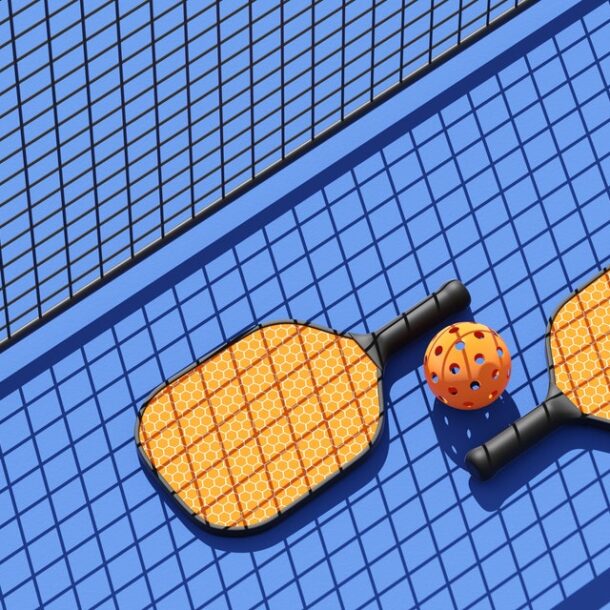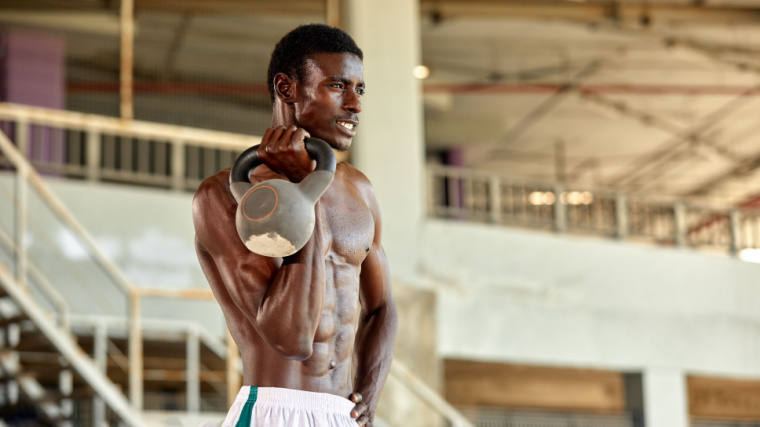
The Best Kettlebell Workouts for Beginners, for Fat Loss, and More – Breaking Muscle
When most people think of a gym, they usually picture a room filled with heavy barbells, a range of dumbbells, and maybe a variety of machines. But, one iron jewel has been dug out of the past and has become increasingly popular over the last 20 years — the kettlebell.
This simple-looking “cannonball with a handle,” often made of cast iron, is a versatile and convenient training tool. It can be easily transported or stored in the corner of your home, and it can be the centerpiece for brutally effective workouts virtually anywhere, for any goal.

Because its center of gravity is away from the handle, this piece of equipment allows for unique exercises (such as kettlebell swings) and unconventional workouts that can’t always be replicated with dumbbells. Sure, you can execute some of the same exercises, but the cardiovascular work will be greater with a kettlebell, as the off-balanced design recruits more muscle mass. Kettlebell training can also help to improve balance, coordination, and core bracing.
Here are some of the best kettlebell workouts for all levels of lifters and a wide range of goals, be it size and strength, conditioning and endurance, or even fat loss.
Best Kettlebell Workouts
Benefits of Kettlebell training
Kettlebells appear to serve the same general purpose as dumbbells. They allow you to train for nearly anything, at any time, and anywhere. (1) But, with the center mass being different, a kettlebell is naturally less stable which provides a different training stimulus. Kettlebells will be slightly less efficient for building raw size because isolating muscles can be difficult due to the added stability challenge, but they are highly effective for building muscular balance and coordination. (2)
As such, kettlebells can provide more “functional” workouts and are particularly useful for athletes. Some kettlebell exercises, like the Turkish get-up, take advantage of this total-body benefit to further improve athletic qualities and conditioning. Because more overall muscle is recruited to stabilize the kettlebell, kettlebell training will also increase the demands on your cardiovascular system, making it a great choice for conditioning. (3)
The off-centered weight and distinctive handle shape allow for unique exercises requiring a swinging or arc motion. This provides even more choice in exercise selection and greater training possibilities. Kettlebells can also be used to perform the same exercises you’d otherwise do with dumbbells.
Best Kettlebell Workouts for Muscle Mass
If your priority is building muscle mass, the kettlebell can be an amazing tool. (4) Focus on the most stable exercises, allowing you to use the heaviest weight to provide the best stimulus for muscle growth. A workout should start with big basic, compound (multi-joint) exercises that recruits the most muscle mass when you’re fresh, so that you can use the most weight while focusing on good form.
Then, you can follow with isolation, single-joint exercise to target a specific muscle or improve your mind-muscle connection. These exercises stimulate less overall muscle mass, but are very useful to focus on a single body part.

To progress, stay in the desired repetition range, performing “hard” sets. Improve over time, either by increasing the number of repetitions or, if available, the weight of the kettlebell. Start relatively light when you first try an exercise — allow time for your nervous system and body to master the technique required. Do not progress too heavy, too fast. Remember that muscle building is a marathon, not a sprint.
Upper Body Kettlebell Muscle-Builder
There are several ways to organize a workout or program, so we’ll detail several routines that you can use depending upon your preferences and schedule. The first one is a workout focusing on the muscles of the upper body and utilizes supersets to hit the muscles with a higher intensity in less time.
Single-Arm Kettlebell Row
- How to Do It: Hinge forward at your hips to assume a bent-over position. Put one hand on a flat bench or a wall to increase total-body stability. Grab the handle of a kettlebell with the other hand, brace your core, and pull your elbow past your hip. Don’t allow your elbows to flare out to the sides. Lower with control to a full stretch.
- Sets and Reps: 4 x 8-12 per arm
- Rest time: No rest between arms. No rest before moving to the next exercise.
Kettlebell Bench Press
- How to Do It: Grab a pair of kettlebells and lie down on a flat bench. Squeeze the handles hard and have the ball of the kettlebell resting on your outer forearm. Begin with your hands near the sides of your chest and your palms facing each other. Retract your shoulder blades and press the weight up while exhaling. As you press up, rotate your palms to face forward. Keep your elbows at a roughly 45-degree angle. Lower with control.
- Sets and Reps: 4 x 6-10
- Rest time: Rest two to three minutes before repeating the previous exercise.
Kettlebell High Pull
- How to Do It: Stand tall while holding a relatively heavy kettlebell in each hand at your side. Brace your core and squeeze your lats, then hinge forward by bending at your hips and knees. When your hands are around knee-level, use your hips as a hinge to thrust the kettlebell upward with as much force as you can. Keep the weights close to your body and pull them toward your chest while squeezing your upper back muscles briefly at the top.
- Sets and Reps: 3 x 6-10
- Rest time: No rest before moving to the next exercise.
Kettlebell Press
- How to Do It: Stand with a pair of kettlebells in the front rack position — holding each kettlebell with your palm facing your chest, elbow tucked under your forearm, wrist straight, and your shoulder pulled down. Brace your core and press the weight up until your arm is fully extended overhead, then lower with control to the starting position.
- Sets and Reps: 3 x 8-12
- Rest time: Rest two to three minutes before repeating the previous exercise.
Kettlebell Lateral Raise
- How to Do It: Stand tall with a pair of kettlebells in your hands by your side. Keep a slight bend in your elbows and raise your arms out your sides until they’re almost parallel to the ground. In the top position, the bottom of the kettlebells should be facing the floor. Be sure to “lead with your elbows” — they should always be slightly higher than your wrists. Think about lifting out, not up, to enhance deltoid stimulus and decrease trapezius activation.
- Sets and Reps: 3 x 10-15
- Rest time: No rest before moving to the next exercise.
Horn Curl
- How to Do It: Stand up straight while holding one kettlebell with both hands, gripping the sides of the handle. Curl the weight by bending at your elbows without moving your upper arms. Make sure your elbows stay in place, by your sides, to really focus on your biceps. Lower to a full stretch.
- Sets and Reps: 3 x 10-15
- Rest time: No rest before moving to the next exercise.
Kettlebell Triceps Extension
- How to Do It: Stand while holding one kettlebell by the sides with both hands. Raise it over your head and fully extend your arms. Without moving anything but your hands and forearms, bend your elbows to slowly lower the weight behind your head. When your arms are fully bent in a comfortable stretch, reverse the movement. Try not to flare your elbows too much — keep your elbows aimed forward.
- Sets and Reps: 3 x 10-15
- Rest time: Rest one to two minutes before repeating the first exercise in the series.
Kettlebell Leg Day
This lower body workout will combine bilateral (two-leg) and unilateral (single-leg) exercises to increase muscle mass while making sure both sides are trained symmetrically. This can also help improve balance and coordination.

The session starts with an explosive movement to really warm-up your knees and activate your nervous system to perform even better later in the workout.
Kettlebell Swing
- How to Do It: Take a shoulder-width or wider stance in front of a kettlebell set on the ground. Hinge forward, making sure to keep your back flat. Grab the kettlebell handle with both hands and pull it backwards until your hands are between your inner thighs. Thrust your hips forward explosively to swing the weight up until it reaches chest- or eye-level. Keep your arms straight. Let the weight go back down between your thighs, without rounding your back. Cycle the movement rhythmically for the desired amount of repetitions.
- Sets and Reps: 5 x 6-10
- Rest time: Rest one minute between sets.
Goblet Squat
- How to Do It: Stand with a kettlebell in the “goblet squat” position — holding the horns (sides of the handle) with the weight resting snugly against your chest. With a roughly shoulder-width stance, squat down as low as your mobility allows. Keep the kettlebell glued to your chest and avoid letting your upper back round forward. Return to an upright position.
- Sets and Reps: 4 x 8-12
- Rest time: Rest two minutes between sets.
Sumo Kettlebell Romanian Deadlift
- How to Do It: Stand with a relatively heavy kettlebell in both hands and widen your stance past shoulder-width. Brace your core and pack your shoulders down. Hinge forward by bending at your hips, barely bending your knees — your legs should almost stay straight. Go as low as possible without rounding your back. Try to feel a deep stretch in your hamstrings. From the bottom position, thrust your hips forward to raise your torso back to the standing position. Squeeze your glutes at the top before repeating repetitions.
- Sets and Reps: 4 x 8-12
- Rest time: Rest two to three minutes between sets.
Front Rack Kettlebell Reverse Lunge
- How to Do It: Hold a pair of kettlebells in the front rack position and stand tall. Take a deep breath and brace your core, then step backward with one leg into a lunge position. Only the toes of your rear leg should be on the floor. Bend your front knee until your rear knee grazes the floor. Stand up by squeezing your glutes and pushing through your front heel. Maintain most of your weight on the front leg during the exercise. Perform all repetitions on one leg before switching sides.
- Sets and Reps: 3 x 10-15 per leg
- Rest time: No rest between legs. Rest two minutes between sets.
Calf Raise
- How to Do It: Stand with your toes on a step or a sturdy item higher than floor level (to allow your heels to drop below your toes). Hold a kettlebell in one hand and hold a stable rack, bench, or wall with the other hand for balance. Let your heels sink down as low as you can with control and pause for a second in the stretched position. Push through the balls of your feet to raise your heels as high as possible and pause for a second in the top position.
- Sets and Reps: 3 x 10-15
- Rest time: Rest one to two minutes between sets.
Fat-Burning Kettlebell Workout
The kettlebell can be a fantastic and efficient tool to shed as much body fat as possible. The compact weight allows you to quickly mobilize a lot of muscle mass and expend lots of energy. For fat loss training to be as effective as possible, you need to use “cyclic” exercises or movements that you can perform for a relatively longer duration, to sustain the energy expenditure.
As such, aim for each bout of effort to last for a significant amount of time. Don’t use too much weight or get too crazy on the pacing — the effort should not be “too hard” because you need it to be sustainable. With this workout, combined with a fat-loss focused diet, you should be able to shed fat while also improving your base cardio and endurance, as you’ll be working in the aerobic zone of cardiovascular conditioning.

This specific workout is a type of EMOM training — every minute on the minute — which implies that you need to set a timer and begin each exercise at the corresponding start of each minute, for a specific number of rounds. If your cardiovascular abilities are limited, start with four rounds of this circuit. Work your way up to six to eight rounds for maximal fat loss. Exercises will be performed “for time” instead of for specific repetitions.
Alternating Kettlebell Swing
- How to Do It: Stand in front of a kettlebell with a wide stance. Hinge forward while keeping a flat back. Grab the kettlebell with one hand and pull it back until your hand is between your inner thighs. Thrust your hips forward explosively to swing the weight up until chest- to eye-level. When the weight reaches its maximum height, quickly and carefully grab it mid-air with your other arm. Let the weight go back down between your thighs, keeping your back stiff and neutral. Repeat hands with each repetition. If the coordination or alternating hands is too challenging, perform basic kettlebell swings.
- Sets and Reps: Four to eight rounds, one total minute of controlled reps.
- Rest time: No rest before moving to the next exercise.
Front Rack Carry
- How to Do It: Stand straight with a pair of kettlebells in the front rack position. Flex your abs, look forward, and start walking with cautious, controlled steps. Brace your core and limit the movement at your hips during the walk. Control the kettlebells and avoid letting the weights bounce as you move. If you don’t have room to walk non-stop, perform a kettlebell march instead: With weights in the front rack position, lift one leg up until your thigh is at a 90-degree angle with the floor, then lower it with control. Switch legs and repeat back and forth.
- Sets and Reps: Four to eight rounds, one total minute of continuous walking.
- Rest time: No rest before moving to the next exercise.
Alternating Kettlebell Snatch
- How to Do It: Stand in front of a kettlebell with a wide stance. Hinge forward with a flat back. Grab the kettlebell with one hand and pull it back until your hand is between your inner thighs. Thrust your hips forward explosively to swing the weight up as high as possible, keeping it close to your body. In one motion, straighten your arm over your head and carefully “catch” the weight by dipping your legs as the kettlebell turns onto the back of your forearm. Lower the weight like a shoulder press, then to your side, keeping it close to your body. Switch hands when the bell is in the bottom position. Hinge to repeat the motion. Alternate hands with each repetition
- Sets and Reps: Four to eight rounds, one total minute of controlled reps.
- Rest time: No rest before moving to the next exercise.
Kettlebell Sit-up and Press
- How to Do It: Hold a kettlebell with both hands while sitting on the floor with your legs straight out. Press the kettlebell over your head, then lower it back to your chest. Keep your heels on the floor and your legs wide. Slowly lower your upper body to the ground until you’re lying down. Flex your abs and dig your heels into the ground to perform a sit-up to return to the seated position.
- Sets and Reps: Four to eight rounds, one total minute of controlled reps.
- Rest time: No rest before moving to the next exercise.
Kettlebell Bob and Weave
- How to Do It: Stand with a kettlebell in the goblet position. Take one foot to the step and descend into a half-squat. Perform a “weaving” or ducking motion with the weight — imagine getting out of the way of a dodgeball coming toward your face. Bend at the waist and keep your torso neutral, don’t round your spine forward. Bring in your other foot and stand up. Then repeat to the opposite side.
Kettlebell Bob and Weave | Kettlebell | Strength and Conditioning Exercises
- Sets and Reps: Four to eight rounds, one minute of bobbing and weaving.
- Rest time: No rest before starting the circuit over.
Iron-Clad Kettlebell Conditioning
If you want to become a lean, mean, non-stop machine and crank up your cardiovascular and endurance capacities, then these workouts are for you. Kettlebells allow you to work on different aspects of conditioning by providing either steady paced, sustainable exercises or high intensity, lactic-acid inducing burnout sessions.
If you’re a bit rusty, cardio-wise, then the fat loss workout will double as an effective base-building plan. When you feel capable of tackling a more challenging routine, you can replace it with one of these or combine them into your weekly program if you’re hungry for faster cardio gains.
Kettlebell Aerobic Power
Here we want to use a variety of exercises for intense bursts of work and incomplete rest — a form of high intensity interval training or HIIT. This stimulates higher oxygen utilization and addresses aerobic abilities of your muscles. Be sure to use a relatively high intensity to really stimulate the aerobic power, which is the functional capacity of the cardiorespiratory system. So make these periods of work count.
You do want the effort to remain sustainable and aerobic, hence the 1:1 work:rest ratio and the inclusion of exercises that you can perform for long duration sets. Perform 30 seconds of work with 30 seconds of rest on each exercise and repeat the circuit a total of four times to create one “block.” Rest two to three minutes between each block and perform two to three blocks per workout.
Kettlebell Clean and Press
- How to Do It: Stand while holding a pair of kettlebells. Swing the weights backward underneath you while hinging forward and keeping a flat back. Maintain a neutral spine and stand up explosively to drive the kettlebells up. Keep the weights close to your body and bring them to the rack position. Pause briefly to stabilize yourself and brace your core. Press both weights overhead to lockout. Carefully lower them to shoulder-level, then lower the weights to your sides. Repeat the entire sequence for each additional repetition.
- Sets and Reps: 30 seconds of work.
- Rest time: Rest 30 seconds before moving to the next exercise.
Kettlebell Burpee
- How to Do It: Stand up holding a pair of kettlebells at your sides. Perform a kettlebell deadlift to place the weights on the floor — slightly bend your legs and drive your hips back without rounding your spine. Keep your hands on the weights, driving the kettlebells into the floor, and carefully “jump” your legs back to land in a push-up position with your arms straight. Perform a full push-up, lowering your body as far as your mobility allows before pressing to lockout. “Jump” your feet toward the weight and stand up by deadlifting the kettlebells while keeping a flat back. Repeat the entire sequence for each repetition.
Burpee Kettlebell Deadlifts
- Sets and Reps: 30 seconds of work.
- Rest time: Rest 30 seconds before moving to the next exercise.
Kettlebell Swing
- How to Do It: Take a shoulder-width or wider stance in front of a kettlebell set on the ground. Hinge forward, making sure to keep your back flat. Grab the kettlebell handle with both hands and pull it backwards until your hands are between your inner thighs. Thrust your hips forward explosively to swing the weight up until it reaches chest- or eye-level. Keep your arms straight. Let the weight go back down between your thighs, without rounding your back. Cycle the movement rhythmically for the desired amount of repetitions.
- Sets and Reps: 30 seconds of work.
- Rest time: Rest 30 seconds before repeating the first exercise.
Kettlebell Anaerobic Development
When the intensity is really high, your body will tap into the anaerobic system and use the phosphagen and glycolytic pathway to produce as much energy as possible. This type of training still uses the aerobic pathway for recovery and it will improve your aerobic base, but it primarily focuses on making you more resilient to intense, shorter bouts of exercise and lactic acid accumulation.
This approach is particularly useful for powerlifters, CrossFitters, and strongmen/strongwomen, as it can help you to sustain very hard work lasting in the 90 to 120-second range while improving glucose storage and utilization. You can use a wide variety of intense exercises, and kettlebells are perfectly fitted for such workouts. For this workout, you want to be pushing yourself hard — aim for 90% of your maximum output. Set a timer to start every four minutes and begin the exercises when it rings. Repeat the entire circuit five or six times.
Thruster
- How to Do It: Hold a pair of kettlebells in the front rack position while standing. Brace your core and squat down until your upper thighs just break parallel. Stand back and use the momentum of your legs to assist you into a smooth transition into an overhead press. Lockout the weights overhead and stabilize your entire body. Lower the kettlebells to the front rack position and repeat.
Double Kettlebell Thruster – CrossFit Exercise Guide
- Sets and Reps: 5-6 x 12
- Rest time: No rest before moving to the next exercise.
Double Kettlebell Snatch
- How to Do It: Stand in front of a pair of kettlebells with a relatively wide stance. Hinge forward, making sure to keep a flat back. Grab the kettlebells and pull them back until your hands are between your inner thighs. Drive your hips forward explosively to bring the weights up, keeping them close to your body as they continue upward. In one motion, straighten your arm over your head and carefully “catch” the weight by dipping your legs as the kettlebells turn onto the back of your forearms. Lower the weights while keeping them close to you, and swing them back past your legs to flow into the next repetition.
- Sets and Reps: 5-6 x 12
- Rest time: No rest before moving to the next exercise.
Kettlebell Burpee
- How to Do It: Stand up holding a pair of kettlebells at your sides. Perform a kettlebell deadlift to place the weights on the floor — slightly bend your legs and drive your hips back without rounding your spine. Keep your hands on the weights, driving the kettlebells into the floor, and carefully “jump” your legs back to land in a push-up position with your arms straight. Perform a full push-up, lowering your body as far as your mobility allows before pressing to lockout. “Jump” your feet toward the weight and stand up by deadlifting the kettlebells while keeping a flat back. Repeat the entire sequence for each repetition.
- Sets and Reps: 5-6 x 12
- Rest time: Rest the remaining of the four minutes before starting the circuit again.
Kettlebell Workout for Beginners
If you’re new to kettlebell training, here’s a workout to ease you into the flow of using an unfamiliar piece of equipment. This basic full-body workout alternates kettlebell staples and more traditional exercises in a circuit to build complete size and strength as well as familiarity with the unique ‘bell. It’s also a great fit for any newer lifter that wants to improve their fitness.
Kettlebell Swing
- How to Do It: Take a shoulder-width or wider stance in front of a kettlebell set on the ground. Hinge forward, making sure to keep your back flat. Grab the kettlebell handle with both hands and pull it backwards until your hands are between your inner thighs. Thrust your hips forward explosively to swing the weight up until it reaches chest- or eye-level. Keep your arms straight. Let the weight go back down between your thighs, without rounding your back. Cycle the movement rhythmically for the desired amount of repetitions.
- Sets and Reps: 4 x 8-12
- Rest time: Rest one minute before moving to the next exercise.
Goblet Squat
- How to Do It: Stand with a kettlebell in the “goblet squat” position — holding the horns (sides of the handle) with the weight resting snugly against your chest. With a roughly shoulder-width stance, squat down as low as your mobility allows. Keep the kettlebell glued to your chest and avoid letting your upper back round forward. Return to an upright position.
- Sets and Reps: 4 x 8-12
- Rest time: Rest one minute before repeating the previous exercise.
Kettlebell Clean and Press
- How to Do It: Stand while holding a pair of kettlebells. Swing the weights backward underneath you while hinging forward and keeping a flat back. Maintain a neutral spine and stand up explosively to drive the kettlebells up. Keep the weights close to your body and bring them to the rack position. Pause briefly to stabilize yourself and brace your core. Press both weights overhead to lockout. Carefully lower them to shoulder-level, then lower the weights to your sides. Repeat the entire sequence for each additional repetition.
- Sets and Reps: 4 x 8-12
- Rest time: Rest one minute before moving to the next exercise.
Kettlebell Row
- How to Do It: Hold a pair of kettlebells with straight arms, brace your core, and hinge forward at your hips to assume a bent-over position. Pull your elbows toward past your hips. Don’t allow your elbows to flare out to the sides. Lower with control to a full stretch.
- Sets and Reps: 4 x 8-12
- Rest time: Rest one minute before repeating the previous exercise.
Turkish Get-Up
- How to Do It: Lie flat on the floor with a kettlebell in one hand near your chest. Press it to lockout and keep your arm straight. Bend your leg on the same side and plant your foot flat on the floor. Raise your torso to sit up, using your opposite hand to brace on the floor — keep your arm locked with the weight overhead. Push through your heels and squeeze your glutes to raise your hips. Sweep your straight leg backward to assume a lunge position. Stand up. Keep your eyes on the weight overhead during the entire movement. Pause briefly in the standing position before reversing the entire sequence.
BreakingMuscle.com – Turkish Get Up
- Sets and Reps: 3 x 5-8 per arm.
- Rest time: No rest between arms. No rest before moving to the next exercise.
Kettlebell Curl
- How to Do It: Stand with a kettlebell in each hand it. Flex your biceps to curl the weight up — keep a neutral or slightly bent wrist, don’t extend your wrist back. Keep your elbows near your sides. Lower to a full stretch.
- Sets and Reps: 3 x 10-15
- Rest time: No rest before moving to the next exercise.
Kettlebell Triceps Extension
- How to Do It: Stand while holding one kettlebell by the sides with both hands. Raise it over your head and fully extend your arms. Without moving anything but your hands and forearms, bend your elbows to slowly lower the weight behind your head. When your arms are fully bent in a comfortable stretch, reverse the movement. Try not to flare your elbows too much — keep your elbows aimed forward.
- Sets and Reps: 3 x 10-15
- Rest time: Rest one to two minutes before repeating the first exercise.
How to Warm-up For Kettlebell Workouts
Just because you’re using a “simple” piece of equipment doesn’t mean you can skip the warm-up. With any workout, a warm-up will prime and activate your body to perform better and minimize the risk of injuries. Your best course of action would be to start with a light cardiovascular activity for five minutes like jumping rope or cycling, then hop into this circuit of exercises.
Figure 8 – Saved by the Bell Kettlebell Circuit
- Figure Eight: Grab a kettlebell in one hand, take a wider than shoulder-width stance, and squat halfway down. Pass the kettlebell between your legs from one hand to the next, forming a “figure eight” pattern — around the inside and outside of one leg, then back between your legs, and to the other side. Keep doing this until you perform 10 “eights,” then stand up.
- Kettlebell Halo: Begin holding the kettlebell by the horns in front of your face. Lift one elbow to maneuver the kettlebell around your head in a tight circle. Bring it around the back of your head and in front of your face. Repeat in the opposite direction. Do 10 reps per side.
- Alternating Kettlebell Swing: Stand in front of the kettlebell with a wide stance. Hinge forward while keeping a flat back. Grab the kettlebell with one hand and pull it back until your hand is between your inner thighs. Thrust your hips forward explosively to swing the weight up until chest- to eye-level. When the weight reaches its maximum height, quickly and carefully grab it mid-air with your other arm. Let the weight go back down between your thighs, keeping your back stiff and neutral. Repeat hands with each repetition. If the coordination or alternating hands is too challenging, perform basic kettlebell swings. Perform 20 to 30 reps.
- Kettlebell Windmill: Press the kettlebell overhead and take a very wide stance. Slightly angle both feet toward the side supporting the weight. Keep your arms and legs straight as you “hinge” and bend in the direction opposite to the weight you’re holding. Keep you arm locked straight and aimed at the ceiling, and descend as far as your mobility allows. Steadily stand back up and pause briefly. Repeat for ten reps before switching to the other side.
Swing Your Way to Fitness
Kettlebells are getting more and more popular for a reason. Practical, versatile, and functional, this lifting equipment can help you reach your goals of muscle size, strength, conditioning, or fat loss. Use these tailored workouts to master the flow of kettlebells and add this incredible, time-tested tool to your fitness kit.
References
- Manocchia, Pasquale1; Spierer, David K.2; Lufkin, Adrienne K. S.1; Minichiello, Jacqueline1; Castro, Jessica1. Transference of Kettlebell Training to Strength, Power, and Endurance. Journal of Strength and Conditioning Research 27(2):p 477-484, February 2013. | DOI: 10.1519/JSC.0b013e31825770fe
- Jay, Kenneth1; Jakobsen, Markus D.1; Sundstrup, Emil1; Skotte, Jørgen H.1; Jørgensen, Marie B.1; Andersen, Christoffer H.1; Pedersen, Mogens T.2; Andersen, Lars L.1. Effects of Kettlebell Training on Postural Coordination and Jump Performance: A Randomized Controlled Trial. Journal of Strength and Conditioning Research 27(5):p 1202-1209, May 2013. | DOI: 10.1519/JSC.0b013e318267a1aa
- Hulsey, Caleb R.1; Soto, David T.1; Koch, Alexander J.2; Mayhew, Jerry L.1,3. Comparison of Kettlebell Swings and Treadmill Running at Equivalent Rating of Perceived Exertion Values. Journal of Strength and Conditioning Research 26(5):p 1203-1207, May 2012. | DOI: 10.1519/JSC.0b013e3182510629
- Lake, Jason P.; Lauder, Mike A.. Kettlebell Swing Training Improves Maximal and Explosive Strength. Journal of Strength and Conditioning Research 26(8):p 2228-2233, August 2012. | DOI: 10.1519/JSC.0b013e31825c2c9b
Featured Image: Miljan Zivkovic / Shutterstock
Related Articles
2023 Healmyselfnow @ All Rights Reserved


